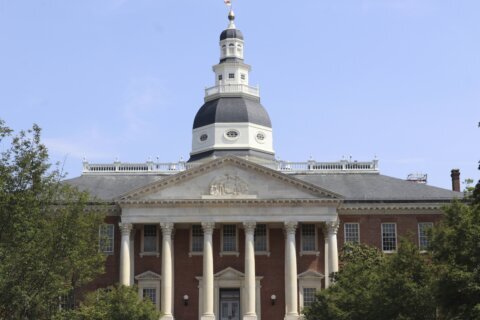This article was republished with permission from WTOP’s news partners at Maryland Matters. Sign up for Maryland Matters’ free email subscription today.
This content was republished with permission from WTOP’s news partners at Maryland Matters. Sign up for Maryland Matters’ free email subscription today.
Top Maryland Transportation Authority leaders have signaled that they intend to tear down the current Nice/Middleton Bridge in Charles County as soon as the replacement span opens to traffic.
That demolition will come over the objections of Maryland’s two U.S. senators and U.S. House Majority Leader Steny Hoyer (D).
Hoyer and Sens. Ben Cardin (D) and Chris Van Hollen (D) asked Transportation Secretary Jim Ports in July to delay action long enough to allow for an “independent” study of the possible re-use of the span for recreational activities.
“With the work on the new Harry W. Nice/Thomas “Mac” Middleton Bridge across the Potomac River proceeding rapidly, we urge the State to reconsider plans to demolish the old bridge, and halt any immediate efforts to do so,” the lawmakers said in a letter.
“These plans should not proceed until a study can be conducted on the feasibility as well as the financial and environmental costs and benefits of converting the old bridge to a non-motorized trail that could be used by pedestrians and bicyclists.”
Bicycling advocates have urged the state for years not to demolish the existing span. When Gov. Larry Hogan (R) unveiled plans to build a replacement bridge, he pledged that the new one would have separate bike and pedestrian lanes. Those plans were later dropped in a cost-cutting move.
During a lengthy discussion at the July meeting of the authority’s board of directors, Ports and Maryland Transportation Authority Executive Director Will Pines said the state offered the bridge to Charles County free of charge in 2019, but the county declined the offer. He said King George County, Va., and the Commonwealth of Virginia both studied the idea of taking possession of the current bridge, but they weren’t interested either.
In his response to the three federal lawmakers, Ports pointed to an analysis that found it would cost nearly $50 million to maintain the 80-year-old bridge for recreational use over the next 30 years. He also said a change in the authority’s plans would require permit modifications. Maryland intends to sink pieces of the existing span “for artificial reef habitat enhancement,” he wrote.
“We’re creating acres of artificial reef that will provide habitat for oysters, fish, et cetera,” Pines told the board. “So it’s an enormous benefit to the [Chesapeake] Bay.”
Pines noted that the lawmakers’ letter included no suggestions for how to fund the study, nor did they identify any organizations willing to take ownership of the bridge if Maryland decides to leave it standing. He also said that keeping the original span in place could lead to sediment buildup on the supports of the new bridge, due to “scouring.”
In their letter to Ports, the lawmakers noted that Maryland is poised to spend between $15 million and $23 million to demolish the original span, money that would be saved if existing plans were set aside.
During the public testimony period, Eric Brenner, the former head of the Maryland Bicycle and Pedestrian Advisory Committee, accused the MdTA board of rushing to get the demolition process to a point where the state’s next governor can’t reverse it.
He praised the lawmakers for suggesting that Maryland “wait on the demolition until you can get somebody with experience in the repurposing of bridges for recreational use,” he said. “MdTA does a lot of great things. This isn’t one of them.”
“I know MdTA really likes operating out here on your own island,” he added. “It’s not too late to try something different.”
Pines told the board that the authority has already begun “some demolition activities on portions of the existing bridge,” even as it continues to carry traffic. “This work started prior to receiving the congressional delegation’s letter,” he said. “But it’s been limited to areas where it does not impact the maintenance of traffic…”
The new bridge is expected to open in early 2023.
The state’ current permit allows for the existing bridge to be dismantled, but Pines told the board that blowing up the old span would save money, though it would require the authority to navigate a complex environmental review. “As you can imagine, if you take something apart piece by piece, it’s more expensive than instantaneously dropping it,” he said.
Brenner said the agency appears determined to punt that decision to the next governor.







